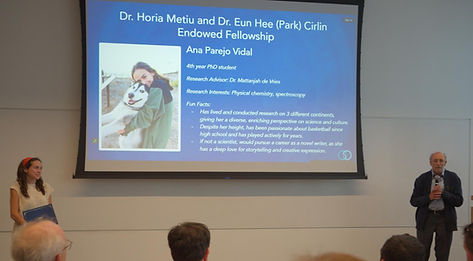Julia Didziulis Expands her Indigo Project by using the Free Electron Laser at the HFML-FELIX Institute

Announcements
Our paper on i-Motif DNA in isolated hemiprotonated cytosine dimers has been named as a HOT paper by the editors of PCCP


Watch Ana Parejo Vidal's Ted x UCSB Talk on The Bright Side of Life!
Watch the full talk here: https://www.youtube.com/watch?v=DXUjbacEmDA
Ana delves into the past to explain how scientists consider the origin of life; examining our biology can provide glimpses of molecules billions of years ago. She discusses her own lab work exploring the hypothesis that light provided the necessary means for life to begin.

Ana was awarded with the " Dr. Horia Metiu and Dr. Eun Hee (Park) Cirling Endowed Fellowship" for her achievements and interest in Physical Chemistry.
She wrote some words about this:
It is a privilege to learn more every day, truly satisfying the curiosity that led me down this path many years ago. However, near the end of my PhD I have spent some time reflecting on my path up until today and how much more I have to learn. My journey into science, like many others, began with a simple yet profound question: “Why do things work the way they do?” In the realm of natural sciences, the ultimate answers often lie within the fascinating world of physical chemistry. From the smallest subatomic particles to the vastness of galaxies, physical chemistry offers insights into the fundamental principles that govern our universe. It’s the foundation upon which we build our understanding of nature, making it one of the purest and most beautiful pursuits of human knowledge. I am one of many scientists who embarked on this journey driven by pure curiosity. I am profoundly appreciative of the opportunity to delve deeper into the mysteries of physical chemistry. Whether conducting research or attending seminars, regardless of the area of chemistry, I enjoy tracing a roadmap in my head that connects complex science with the fundamental concepts I thrive on. I imagine chemical reactions as a complex dance of electrons, protons, and neutrons, balancing in instantaneous equilibria. In the most reductionist approach to science, everything involves physical chemistry: Biology: Gibbs free energy to dictate stabilities of protein foldings, while kinetics determine the folding pathway and rate. Materials Eng: New alloys are developed by applying principles of thermodynamics and kinetics, mapping unprecedented materials with properties essential for aerospace and automotive industries. Electrical Eng: Quantum mechanics explains the band structure, electron mobility, and doping processes allows engineers to design and optimize semiconductors for use in electronic devices like solar cells, and LEDs. Biochemistry: Biochemists study enzyme catalysis using concepts like transition state theory and enzyme kinetics. Biotechnology: Biotechnologists design efficient drug delivery systems by understanding the interactions between drugs and biological membranes, as well as the thermodynamics and kinetics of drug release. Understanding the general aspects of so many fields of research is incredibly fulfilling for me. I am very grateful to the department for their recognition. While I don't know what the future holds after my PhD, I am certain that this journey has transformed my perspective of the world in ways for which I am deeply thankful. I see my future full of unknown challenges, but I am equipped with the invaluable foundation, resources, and capacity to explore the wonderful mysteries that life presents.

Second-year grad student Julia Didziulis presented at the International Symposium on Molecular Spectroscopy at the University of Illinois, Urbana-Champaign
She presented her talk "Excited-State Dynamics of Indigo Isomers via REMPI-MS" in the Dynamics and Kinetics division of the conference, and spent the rest of the week attending presentations and meeting spectroscopists from around the world!
